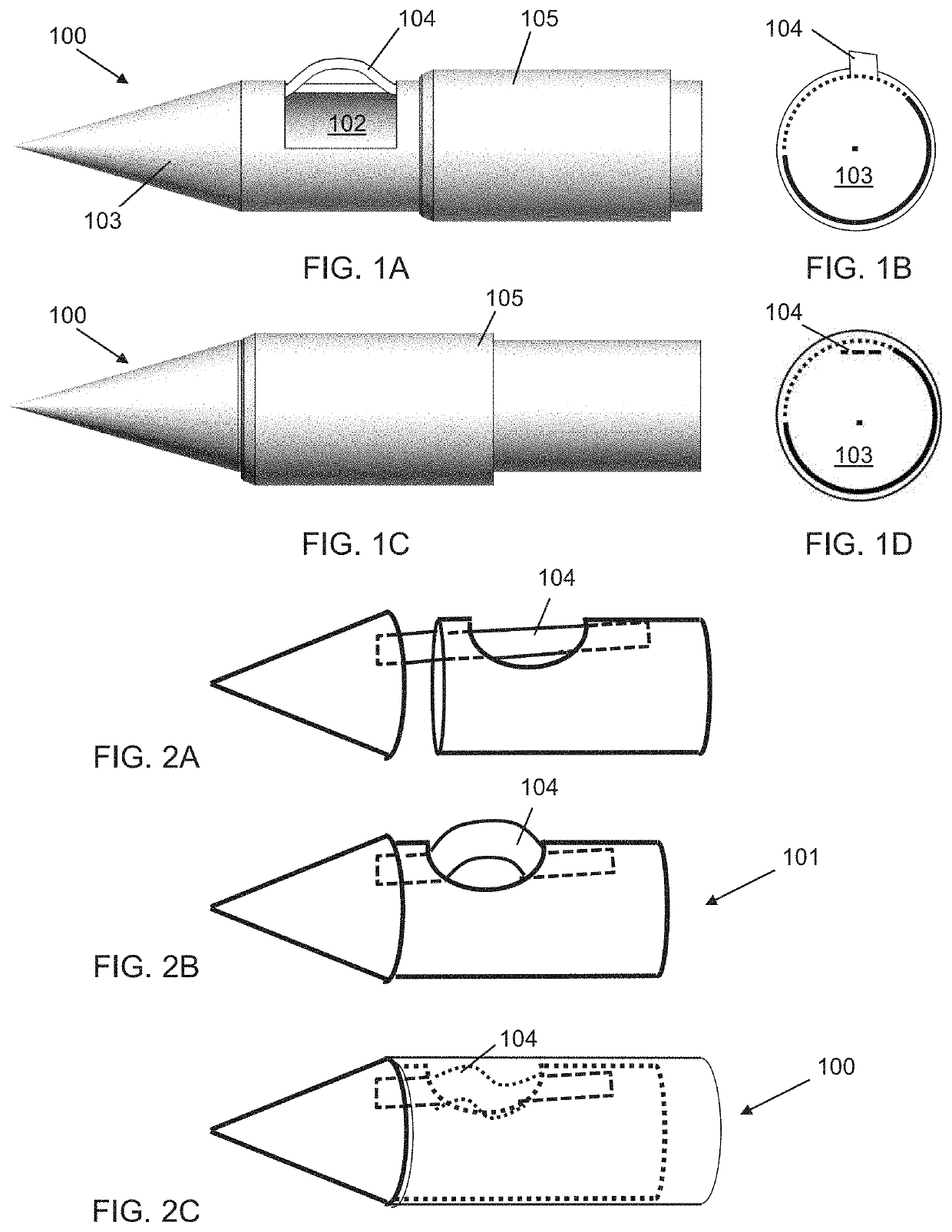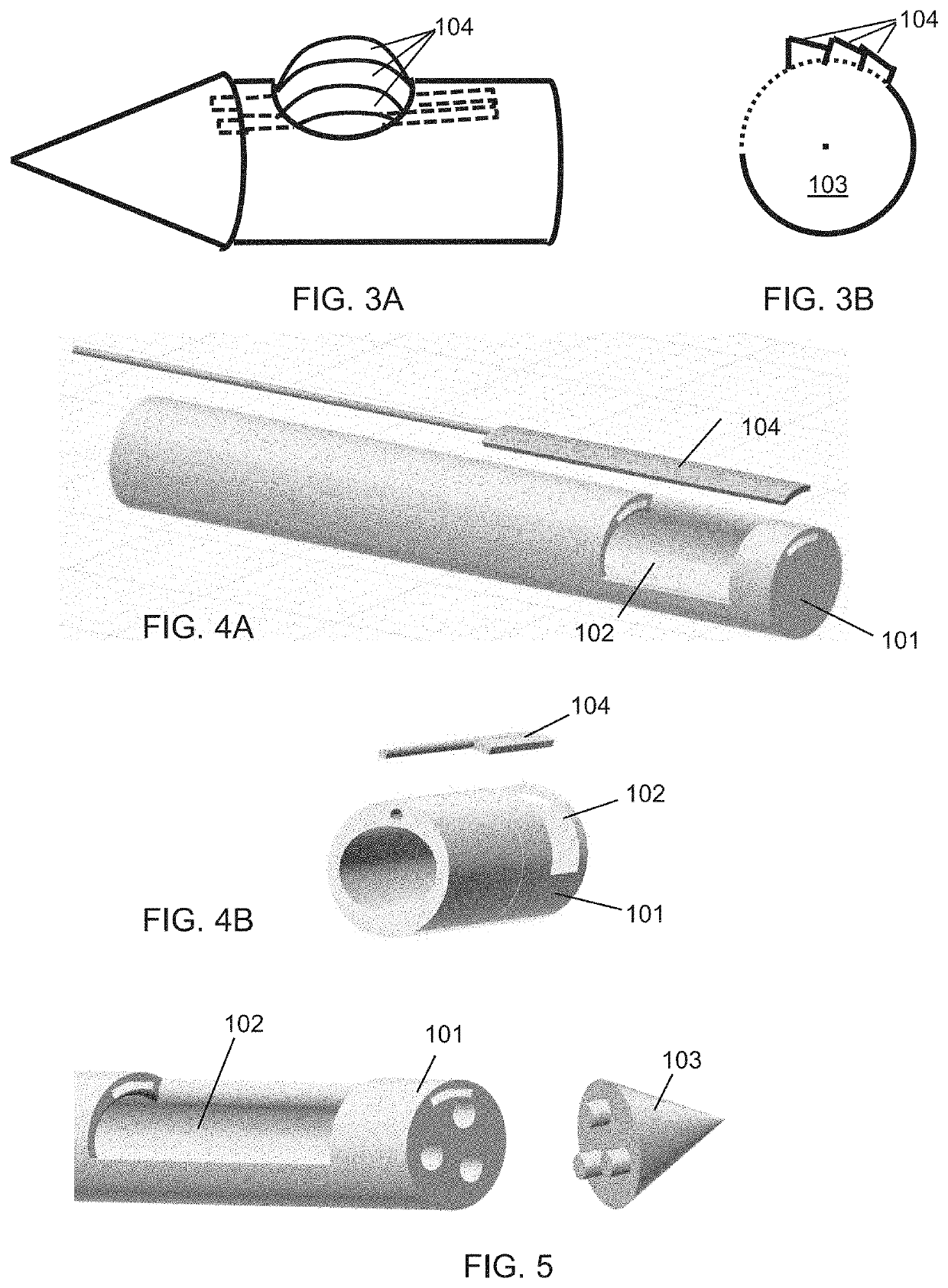Biopsy system for enhanced tissue harvesting
a biopsy system and tissue harvesting technology, applied in the field of biopsy systems, can solve the problems of increasing the likelihood of complications such as bleeding or even death, increasing the number of procedures, and increasing so as to improve diagnostic ultrasound guidance, reduce the number of passes, and harvest large volumes of tissue
- Summary
- Abstract
- Description
- Claims
- Application Information
AI Technical Summary
Benefits of technology
Problems solved by technology
Method used
Image
Examples
example 1
[0158]A non-limiting example of the biopsy needle device prototype of the present invention, herein referred to as the Triopsy needle, is shown in the top image of FIG. 26A. The inset provides the details of the 3D prototype. The 3D printed Triopsy needle is attached to a syringe after having aspirated a tofu-tissue model. The bottom image of FIG. 26A shows an exact-sized hollow needle without the dome, which is a model of standard full-core biopsy needles. FIG. 26B shows the result of 4 trials with the various biopsy needle types having been inserted equal depths and spun 5 times clockwise under different relative vacuum pressures. Significantly more tissue was harvested using the novel Triopsy-type needle (two-tailed paired t-test p2>0.9, p<0.01) between mm of model tissue aspirated into the tubing and dry weight of the harvested tissue not shown.
[0159]FIG. 26C shows a theoretical comparison of amount of tissue harvested using current industry standard biopsy needles and using the...
example 2
ocedure
[0160]The biopsy needle includes a sheath through which biopsy device and other accessories can be inserted. Accessories include electrocautery device, radioopaque marker insertion device, tissue sealant injector, device to inject filler material, etc.[0161]1. Prepare device: use syringe to apply suction; turn stopcock to preserve vacuum.[0162]2. Use ultrasound guidance to advance needle / outer sheath into patient and position at distal end of tumor.[0163]3. Use mechanics to retract outer sheath to expose expandable curved cutting blade and needle lumen.[0164]4. Use stopcock to apply vacuum to needle lumen.[0165]5. Rotate device to collect tissue biopsy (manual, motor driven, spring driven).[0166]6. Stop rotation and reposition outer sheath.[0167]7. Collect biopsy using vacuum and store in collection chamber[0168]8. Use stopcock to close vacuum[0169]9. Disengage outer sheath (luer adapter) from biopsy needle unit, if desired[0170]10. Remove needle unit; sheath (optionally) rem...
example 3
ocedure Triopsy Edge Complex Device
[0181]1. Apply grounding pad to patient and attach to electrocautery unit. Attach electrocautery unit to biopsy device.[0182]2. Insert needle and sheath into patient under external imaging (e.g. ultrasound) visualization.[0183]3. Position within the tumor, preferably distally for pullback biopsy.[0184]4. Press start button to activate device. Solid green ready light appears.[0185]5. Press start button to begin biopsy process. Green light begins to blink.[0186]6. Outer sheath retracts.[0187]7. Vacuum starts.[0188]8. Electrosurgery signal directed to cutting blade.[0189]9. Needle begins to rotate for n rotations (n=1-20).[0190]10. Electrosurgery inactivated.[0191]11. Outer sheath extends distally.[0192]12. Vacuum continues to collect tissue.[0193]13. Vacuum turns off.[0194]14. Solid green light reappears-ready light.[0195]15. Reposition biopsy device to starting position.[0196]16. Depress and hold button to activate electrocautery.[0197]17. Inactivat...
PUM
 Login to View More
Login to View More Abstract
Description
Claims
Application Information
 Login to View More
Login to View More - R&D
- Intellectual Property
- Life Sciences
- Materials
- Tech Scout
- Unparalleled Data Quality
- Higher Quality Content
- 60% Fewer Hallucinations
Browse by: Latest US Patents, China's latest patents, Technical Efficacy Thesaurus, Application Domain, Technology Topic, Popular Technical Reports.
© 2025 PatSnap. All rights reserved.Legal|Privacy policy|Modern Slavery Act Transparency Statement|Sitemap|About US| Contact US: help@patsnap.com



